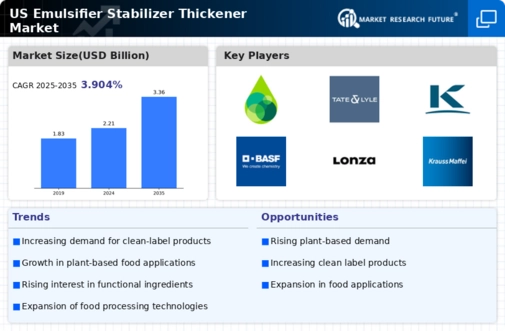Health and Wellness Trends
The growing focus on health and wellness among consumers is a pivotal driver for the emulsifier stabilizer-thickener market. As individuals become more health-conscious, there is a rising demand for products that offer functional benefits without compromising on taste or texture. This trend is particularly evident in the development of low-fat, low-sugar, and gluten-free products, which often rely on emulsifiers and thickeners to maintain desirable mouthfeel and consistency. The market is likely to see an increase in the formulation of functional foods that cater to specific dietary needs, such as those targeting digestive health or weight management. Consequently, the emulsifier stabilizer-thickener market must adapt to these health trends, fostering innovation in product development to meet consumer expectations.
Rising Demand for Clean Label Products
The emulsifier stabilizer-thickener market experiences a notable surge in demand for clean label products, driven by consumer preferences for transparency and natural ingredients. As consumers increasingly scrutinize food labels, manufacturers are compelled to reformulate products using fewer synthetic additives. This trend is particularly pronounced in the food and beverage sector, where the clean label movement is projected to grow at a CAGR of approximately 8% through 2025. Consequently, the market must adapt to these evolving consumer expectations, leading to innovations in natural emulsifiers and thickeners that align with clean label principles. This shift not only enhances product appeal but also fosters brand loyalty among health-conscious consumers, thereby propelling market growth.
Expansion of the Food and Beverage Sector
The emulsifier stabilizer-thickener market benefits significantly from the ongoing expansion of the food and beverage sector in the US. With the market size estimated to reach $1 trillion by 2025, the demand for emulsifiers and stabilizers is expected to rise correspondingly. This growth is fueled by increasing consumer interest in convenience foods, ready-to-eat meals, and processed snacks, which often require emulsifiers and thickeners to achieve desired textures and stability. Additionally, the rise of plant-based alternatives further drives the need for effective emulsifiers that can enhance the mouthfeel and consistency of these products. As the food and beverage industry continues to evolve, the market is poised to capitalize on these trends, ensuring a steady demand for innovative solutions.
Sustainability Initiatives in Food Production
Sustainability initiatives within the food production sector are increasingly influencing the emulsifier stabilizer-thickener market. As environmental concerns gain prominence, manufacturers are seeking to reduce their carbon footprint and adopt sustainable sourcing practices. This shift is prompting the development of plant-based emulsifiers and thickeners derived from renewable resources, which align with consumer preferences for eco-friendly products. The market is likely to witness a growing emphasis on sustainable practices, including the use of biodegradable packaging and waste reduction strategies. As companies strive to meet sustainability goals, the emulsifier stabilizer-thickener market may experience a transformation, with an emphasis on innovation that prioritizes environmental responsibility.
Technological Advancements in Food Processing
Technological advancements in food processing techniques are reshaping the emulsifier stabilizer-thickener market. Innovations such as high-pressure processing and microencapsulation are enabling manufacturers to enhance the functionality of emulsifiers and thickeners, improving their performance in various applications. These advancements not only optimize product formulations but also extend shelf life and improve sensory attributes. As food manufacturers increasingly adopt these technologies, the emulsifier stabilizer-thickener market is likely to witness a shift towards more efficient and effective solutions. Furthermore, the integration of automation and smart technologies in production processes may lead to cost reductions and increased production efficiency, thereby benefiting the overall market landscape.





















Leave a Comment